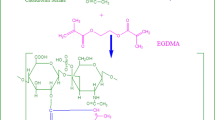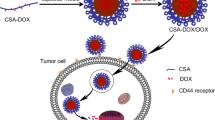Abstract
Poly(N-isopropylacrylamide) (PNIPAAm) is formed by polymerization of the monomer N-isopropylacrylamide (NIPAAm) and is classified as thermosensitive due to its ability to expand and contract at a certain temperature. Chondroitin sulfate is called bioadhesive as it increases the permanence time of the drug in the body, enhancing its bioavailability. In this study, the copolymer chondroitin sulfate-co-N-isopropylacrylamide (CSM) is proposed as a new drug carrier and thermal analysis is used to choose among the copolymers CSM + NIPAAm 5 % (w/v), CSM + NIPAAm 2.5 % (w/v) and CSM + PNIPAAm 2.5 % (w/v), the one with best thermal properties. Proton nuclear magnetic resonance spectroscopy showed structural similarity between the copolymers. Thermogravimetric analysis/derivative thermogravimetry showed that the copolymer CSM + NIPAAm 5 % (w/v) has higher thermal stability when compared to the others. Differential thermal analysis showed thermal values consistent with the events of decomposition while kinetics of degradation confirmed its thermal stability. So the copolymer CSM + NIPAAm 5 % (w/v) presented the best thermal characteristics for an efficient drug carrier.







Similar content being viewed by others
References
Seitz J, Metha S, Yeager JL. Revestimento de Comprimidos. In: Lachman L, Lieberman HA, Kanig J, editors. Teoria e Prática na Indústria Farmacêutica. 2nd ed. Lisboa: Fundação Calouste Gulbenkian; 2001. p. 599–650.
Zheng W, Sauer D, Mcginity JW. Influence of hydroxyethylcellulose on the drug release properties of theophylline pellets coated with Eudragit RS 30 D. Europ J Pharm Biopharm. 2005;59:147.
Bunhak EJ, Mendes ES, Pereira NC, Cavalcanti O. Influência do sulfato de condroitina na formação de filmes isolados de polimetacrilato: avaliação do índice de intumescimento e permeabilidade ao vapor d’água. Quim Nov. 2007;30:312–3.
Roseman S. Reflections on glycobiology. J Biol Chem. 2001;276:41527–42.
Santos CV. Sulfato de condroitina: da matéria-prima à terapêutica. Porto Alegre: Universidade Federal do Rio Grande do Sul; 2009.
Villanova JCO, Oréfice RL, Cunha AS. Aplicações Farmacêuticas de Polímeros. Polímeros Ciência e Tecnologia. 2010;20:53–5.
Andrews GP, Laverty TP, Jones DS. Biopharmacology. Europ J Pharm. 2009;71:505.
Lopes AC, Caparros C, Ribelles JLG, Neves IC, Lanceros-Mendez S. Electrical and thermal behavior of c-phase poly(vinylidene fluoride)/NaY zeolite composites. Microporous Mesoporous Mater. 2012;161:98–105.
Kunita MH. Enxertia de metacrilato de glicidila em filmes poliméricos por processo com fluidos supercríticos. Universidade Estadual de Maringá; 2005.
Glycidyl Methacrylate (GMA). In: A high purity, dual functionality monomer for coatings and resins. 2012. http://www.acrylicmonomers.com of subordinate document. Accessed 15 Feb 2012.
Reis AV, Cavalcanti OA, Rubira AF, Muniz EC. Synthesis and characterization of pH-responsive hydrogels based on chemically modified Arabic gum polysaccharide. Polymer. 2006;47:2023.
Reis AV, Guilherme MR, Almeida EAMS, Kunita MH, Muniz EC, Rubira AF, Tambourgi EB. Copolymer hydrogel spheres consisting of modified sulfate chondroitin-co-poly(N-isopropylacrylamide). J Appl Polym Sci. 2010;1–9.
Berger J, et al. Structure and interaction in covalently and ionically crosslinked chitosan hydrogels for biomedical applications. Europ J Pharm Biopharm. 2004;57:19–34.
Gao G, Mohwald H, Shen J. Thermosensitive poly (allylamine)-g-poly (N-isopropylacrylamide): synthesis, phase separation and particle formation. Polymer. 2005;46:4088.
Guilherme MR, Moura MR, Radovanovic E, Geuskens G, Rubira AF, Muniz EC. Novel thermo-responsive membranes composed of interpenetrated polymer networks of alginate-Ca2+ and poly(N-isopropylacrylamide). Polymer. 2005;46:2668–74.
Eeckman F, Möes AJ, Amighi K. Synthesis and characterization of thermosensitive copolymers for oral controlled drug delivery. Eur Polym J. 2004;40:873.
Takeda N, Nakamura E, Yokoyama M, Okano T. Temperature-responsive polymeric carriers incorporating hydrophobic monomers for effective transfection in small doses. J Control Release. 2004;95:343.
Campese GM, Tambourgi EB, Guilherme MR, Moura MR, Muniz EC, Youssef EY. Resistência mecânica de hidrogéis termo-sensíveis constituídos de alginato-ca2+/pnipaam, tipo semi-ipn. Quim Nov. 2007;30:1649–50.
Rathjen CM, Park C, Goodrich PR, Walgenbach DD. The effect of preparation temperature on some properties of a temperature-sensitive hydrogel. Polym Gel Netw. 1995;3:101–15.
Alvarez-Lorenzo C, Concheiro A, Dubovik AS, Grinberg NV, Burova TV, Grinberg VY. Temperature-sensitive chitosan-poly(N-isopropylacrylaminde) interpenetrated networks with enhanced loading capacity and controlled properties. J Control Release. 2005;102:629–41.
Feil H, Bae YH, Feijen J, Kim SW. Mutual influence of pH and temperature on the swelling of ionizable and thermosensitive hydrogels. Macromolecules. 1992;25:5528–30.
Chavanpatil MDP, Jain S, Chaudhari R, Shear PRV. Novel sustained release, swellable and bioadhesive gastroretentive drug delivery system for ofloxacin. Intern J Pharm. 2006;316:86–92.
Lyramam Soares-Sobrinho JL, Brasileiro MT, Roca MFL, Barraza JA, Viana OS, Rolim-Neto PJ. Sistemas Matriciais Hidrofílicos e Mucoadesivos para Liberação Controlada de Fármacos. Lat Am J Pharm. 2007;26:5.
Vendruscolo CW, Andreazz IF, Ganter JLMS, Ferrero C, Bresolin MB. Xanthan and galactomannan (from M. scabrella) matrix tablets for oral controlled delivery of theophylline. Int J Pharm. 2005;296:1–11.
Xia X, Hu Z, Marquez M. Physically bonbed nanoparticle networks, a novel drug delivery system. J Control Release. 2005;103:21–30.
Langer R, Peppas NA. Advances in biomaterials, drug delivery, and bionanotechnology. AIChE J. 2003;49:2990–3006.
Griffith LG. Polymeric biomaterials. Acta Mater. 2000;48:263–77.
Aragão CFS, Souza FS, Barros ACS, Veras JWE, Barbosa Filho JM, Macedo RO. Aplicação da termogravimetria (TG) no controle de qualidade da milona (Cissampelos sympodialis Eichl.) Menispermaceae. Rev Bras Farmacogn. 2002;12:60–1.
Barral L, Dıez FJ, Garcia-Garabal S, Lopez J, Montero B, Montes R, Ramirez C, Rico M. Thermodegradation kinetics of a hybrid inorganic–organic epoxy system. Europ Polym J. 2005;41:1662–6.
Vermal RK, Sanjay G. Formulation aspects in the development of osmotically controlled oral drug delivery systems. J Pharm Biom Anal. 2005;38:633–44.
Wendhausen PAP, Rodrigues GV, Marchetto O. Análises Térmicas: caracterização de materiais III. Santa Catarina: Universidade Federal de Santa Catarina; 2006.
Reading M, Craig MQD. Thermal analysis of pharmaceuticals. 1rd ed. Kindle Edition; 2007.
Viana OS, Araújo AAS, Simões RA, Soares JL, Matos CRS, Grangeiro-Júnior S, Lima CM, Rolim-Neto PJ. Kinetic analysis of the thermal decomposition of efavirenz and compatibility studies with selected excipients. Lat Am J Pharm. 2008;2:211–6.
Alves TVG, Tavares EJM, Aouada FA, Negrão CAB, Oliveira MEC, Duarte Junior AP, Costa CEF, Silva Junior JOC, Costa RMR. Thermal analysis characterization of PAAm-co-MC hydrogels. J Therm Anal Calorim. 2011;106:717–24.
Costa RS, Negrão CAB, Camelo SRP, Ribeiro-Costa RM, Barbosa WLR, Costa CEF, Silva Júnior JOC. Investigation of thermal behavior of Heliotropium indicum L. lyophilized extract by TG and DSC. J Therm Anal Calorim. 2013;111:1959–64.
Costa MNF, Muniz MAP, Negrão CAB, Costa CEF, Lamarão MLN, Morais L, Silva Júnior JOC, Ribeiro-Costa RM. Characterization of Pentaclethra macroloba oil. J Therm Anal Calorim. 2014;115:2269–75.
Pham QT, Chern CS. Thermal stability of organofunctional polysiloxanes. Thermochim Acta. 2013;565:114–23.
Flynn JH, Wall LA, Ozawa T. Methods. J Resp Nat. 1996;487.
Lee CT, Huang CP, Lee YD. Synthesis and characterizations of amphiphilic poly(l-lactide)-grafted chondroitin sulfate copolymer and its application as drug carrier. Biom Eng. 2007;24:131–9.
Reis AV, Guilherme MR, Mattos LHC, Rubira AF, Tambourgi EB, Muniz EC. Nanometer- and submeter-sized hollow spheres of chondroitin sulfate as a potential formulation strategy for anti-inflammatory encapsulation. Pharm Res. 2008;1–7.
Robb SA, Lee BH, Mclemore R, Vernon BL. Simultaneously physically and chemically gelling polymer system utilizing a poly(NIPAAm-co-cysteamine) based copolymer. Biomacromolecule. 2007;8:2294–300.
Garay TM, Liamas CM, Iglesias E. Study of polymer-polymer complexes and blends of poly(N-isopropylacrylamide) with poly(carboxylic acid): 1. poly(acrylic acid) and poly(methacrylic acid). Polymer. 1997;38:5091–6.
Ying L, Kang ET, Neoh KG. Characterization of membranes prepared from blends of poly(acrylic acid)-graft-poly(vinylidene fluoride) with poly(N-isopropylacrylamide) and their temperature-and pH-sensitive filtration. J Membr Sci. 2003;224:93–106.
Saeed A, Georget DMR, Mayes AG. Solid-state thermal stability and degradation of a family of poly(N-isopropylacrylamide-co-hydroxymethylacrylamide) copolymers. J Polym Sci Part A Polym Chem. 2010;48:5848–55.
Silva FB. Síntese e caracterização de hidrogéis de Poli[(n-isopropilacrilamida)-co-(ácido metacrílico)] e sua aplicação como sistemas de liberação controlada de medicamentos. Minas Gerais: Universidade Federal de Minas Gerais; 2006.
Fajardo AR, Piai JF, Rubira AF, Muniz EC. Time- and pH-dependent self-rearrangement of a swollen polymer network based on polyelectrolytes complexes of chitosan/chondroitin sulfate. Carbohydr Polym. 2010;80:934–43.
Fajardo AR, Antonio LCL, Pereira GBA, Rubira F, Muniz ED. Polyelectrolyte complexes based on pectin–NH2 and chondroitin sulfate. Carbohydr Polym. 2012;87:1950–5.
Wang LF, Shena SS, Lu SC. Synthesis and characterization of chondroitin sulfate–methacrylate hydrogels. Carbohydr Polym. 2003;52:389–96.
Iqbal MS, Jamil Y, Kausar T, Akhtar M. Thermal degradation study of glycidyl methacrylate acrylonitrile copolymers. J Therm Anal Calorim. 2009;96:225–33.
Neto CGT, Giacometti JA, Job AE, Ferreira FC, Fonseca JLC, Pereira MR. Thermal analysis of chitosan based networks. Carbohydr Polym. 2005;62:97–103.
Batista NL, Costa ML, Iha K, Botelho EC. Avaliação da degradação térmica e estimativa da vida útil de compósitos poli(éter imida)/fibra de carbono. 12° Congresso Brasileiro de Polímeros; 2013.
Paoli MA. Degradação e estabilização de polímeros. 2rd ed. Chemkeys; 2008.
Acknowledgements
The authors thank CNPq, PROPESP/UFPA and FADESP for the financial support, EMBRAPA Amazônia Oriental, Faculty of Chemistry and Laboratory of Quality Control and Toxicology, which are part of the Faculty of Pharmacy, Federal University of Pará for their assistance in the experimental stage.
Author information
Authors and Affiliations
Corresponding author
Rights and permissions
About this article
Cite this article
da Costa Sanches, S.C., de Vasconcelos, F., da Costa, C.E.F. et al. Thermal characterization study of chondroitin sulfate-co-N-isopropylacrylamide as drugs carrier. J Therm Anal Calorim 120, 991–999 (2015). https://doi.org/10.1007/s10973-014-4380-4
Received:
Accepted:
Published:
Issue Date:
DOI: https://doi.org/10.1007/s10973-014-4380-4




